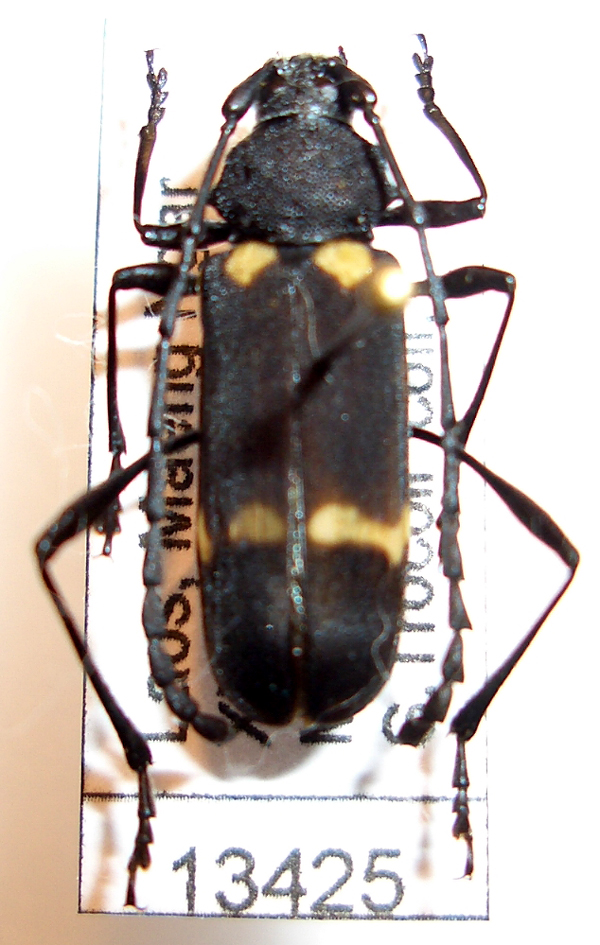| Author |
 Topic Topic  |
|
|
Sergi
Member Rosenbergia
   
Spain
1748 Posts |
 Posted - 06/01/2014 : 12:28:22 Posted - 06/01/2014 : 12:28:22



|

387.56 KB
From Laos, Size: 15 mm |
Edited by - Xavier on 06/01/2014 15:42:05 |
|
|
Xavier
Scientific Collaborator
    
France
12338 Posts |
 Posted - 06/01/2014 : 15:41:22 Posted - 06/01/2014 : 15:41:22



|
| It should be a female of Purpuricenus malaccensis (Lacordaire, 1869) with reduced macules. |
 |
|
|
Sergi
Member Rosenbergia
   
Spain
1748 Posts |
 Posted - 06/01/2014 : 16:15:10 Posted - 06/01/2014 : 16:15:10



|
I thought in a form of Purpuricenus quadrinotatus.... |
 |
|
|
Xavier
Scientific Collaborator
    
France
12338 Posts |
 Posted - 06/01/2014 : 17:32:51 Posted - 06/01/2014 : 17:32:51



|
Well, Purpuricenus quadrinotatus White is a species from Australia...No way to find it in Laos, no ?
You never check with Titan database ? It's the most important work for Longhorn beetles bibliography. |
 |
|
|
Sergi
Member Rosenbergia
   
Spain
1748 Posts |
 Posted - 06/01/2014 : 17:52:45 Posted - 06/01/2014 : 17:52:45



|
| I believe that there are specimens of P. quadrinotatus from Indonesia and perhaps Malaysia... |
 |
|
|
Xavier
Scientific Collaborator
    
France
12338 Posts |
 Posted - 06/01/2014 : 18:28:59 Posted - 06/01/2014 : 18:28:59



|
| Interesting ! If you can share a picture of it... |
 |
|
|
Sergi
Member Rosenbergia
   
Spain
1748 Posts |
|
|
Xavier
Scientific Collaborator
    
France
12338 Posts |
 Posted - 06/01/2014 : 18:50:06 Posted - 06/01/2014 : 18:50:06



|
| OK, thanks. Female antenna are shorter than P. malaccensis |
 |
|
|
Sergi
Member Rosenbergia
   
Spain
1748 Posts |
 Posted - 06/01/2014 : 18:58:02 Posted - 06/01/2014 : 18:58:02



|
Yes, but my insect is different from both species!!! undoubtedly I believe that is a Purpuricenus  |
 |
|
|
Xavier
Scientific Collaborator
    
France
12338 Posts |
 Posted - 06/01/2014 : 19:49:25 Posted - 06/01/2014 : 19:49:25



|
Coming from Laos, your specimen is for me probably P. malaccensis female. Purpuricenus species vary a lot. I can't say more...
|
 |
|
|
Sergi
Member Rosenbergia
   
Spain
1748 Posts |
 Posted - 09/01/2014 : 13:15:25 Posted - 09/01/2014 : 13:15:25



|
| looking images, could be Purpuricenus sanguinolentus???? a form of it. |
 |
|
|
Xavier
Scientific Collaborator
    
France
12338 Posts |
 Posted - 09/01/2014 : 13:28:15 Posted - 09/01/2014 : 13:28:15



|
| You have to observe the pronotal structure. Reading this post could help you ? |
 |
|
|
Vitali
Member Rosenbergia
   
Estonia
1001 Posts |
 Posted - 09/01/2014 : 13:53:59 Posted - 09/01/2014 : 13:53:59



|
The difference in pronotal structure can be observed only in males. Females are more difficult to understand as usual.
According to Gahan, 1906 P. malaccensis should have in general yellow bands narrower than those in P.sanguinolentus. The colour pattern in Sergi's beetle is surprisingly similar to that in P. quadrinotatus. I have a big series of the two former species, shall have a look whether there is any specimen similar to Sergi's. |
 |
|
|
Vitali
Member Rosenbergia
   
Estonia
1001 Posts |
 Posted - 09/01/2014 : 19:27:53 Posted - 09/01/2014 : 19:27:53



|
I found one male of Purpuricenus sanguinolentus with the extreme form of a colour pattern (see photo below). Probably the extreme forms of P. malaccensis can be even darker, as their yellow bands should be mostly narrower.
By the way, regarding the shapes of puncture areas in pronotum, some males look like transition forms between the two species. Are these really good species?

185.86 KB |
 |
|
| |
 Topic Topic  |
|


